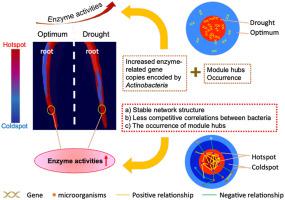Soil Biology and Biochemistry ( IF 9.8 ) Pub Date : 2021-07-15 , DOI: 10.1016/j.soilbio.2021.108360 Xuechen Zhang 1, 2, 3 , David D. Myrold 4 , Lingling Shi 2, 5, 6 , Yakov Kuzyakov 7, 8, 9 , Hongcui Dai 1, 2 , Duyen Thi Thu Hoang 10 , Michaela A. Dippold 2 , Xiangtian Meng 11 , Xiaona Song 2 , Ziyan Li 12 , Jie Zhou 2 , Bahar S. Razavi 3

|
Climate change impacts soil microbial communities, activities and functionality. Nonetheless, responses of the microbiome in soil microenvironments with contrasting substrate availability in the rhizosphere to climatic stresses such as drought are largely unknown. To fill this knowledge gap, we coupled soil zymography with site-specific micro-sampling of the soil and subsequent high-throughput sequencing. This helped identify how the bacterial community structure and the genes encoding N-cycling enzymes (leucine aminopeptidase and chitinase) in rhizosphere hotspots and coldspots (microsites with activities in the range of bulk soil but localized within the rhizosphere) of maize respond to drought (20% WHC, two weeks).
The elevated activities of leucine aminopeptidase and chitinase in rhizosphere hotspots were caused by the tight collaborative relationships between bacteria and their stable network structure rather than by any significant shift in bacterial community structure or enzyme-encoding gene copies. Despite the similarity in bacterial community structure in soil under drought and optimal moisture, functional predictions indicated the increased relative abundance of genera belonging to Actinobacteria capable of leucine aminopeptidase and chitinase production, especially Streptomyces, Nocardioides, Marmoricola, and Knoellia. Accordingly, the number of gene copies encoded by Actinobacteria for these two enzymes increased by 5.0–17% under drought. Among the bacteria with increased relative abundance under drought, Luedemannella played a crucial role in mediating nutrients and energy fluxes between bacteria. This was reflected in a 35–70% increase in leucine aminopeptidase and chitinase activities under drought. The resistance of enzyme activities to drought was higher in hotpots than that in coldspots. These results revealed that rhizosphere bacterial community composition remained stable, and that the number of gene copies encoded by Actinobacteria responsible for N-cycling enzymes increased under drought. The expected reduction of processes of N cycle was absent. Instead, bacteria increased N mining rate in those hotspots remaining active despite water scarcity.
中文翻译:

根际热点地区微生物群落的抗性及其对干旱的功能敏感性
气候变化影响土壤微生物群落、活动和功能。尽管如此,土壤微环境中的微生物组与根际底物可用性对比对气候胁迫(如干旱)的反应在很大程度上是未知的。为了填补这一知识空白,我们将土壤酶学与土壤特定地点的微量采样和随后的高通量测序相结合。这有助于确定玉米的根际热点和冷点(在大块土壤范围内活动但位于根际内的微型站点)中的细菌群落结构和编码 N 循环酶(亮氨酸氨肽酶和几丁质酶)的基因如何应对干旱(20 % WHC,两周)。
根际热点中亮氨酸氨肽酶和几丁质酶活性的升高是由细菌与其稳定网络结构之间的紧密协作关系引起的,而不是由细菌群落结构或酶编码基因拷贝的任何显着变化引起的。尽管在干旱和最佳水分条件下土壤中细菌群落结构相似,但功能预测表明,属于能够产生亮氨酸氨肽酶和几丁质酶的放线菌属的相对丰度增加,尤其是链霉菌属、诺卡氏菌属、马莫里科拉属和Knoellia 属。因此,放线菌编码的基因拷贝数这两种酶在干旱条件下增加了 5.0-17%。在干旱条件下相对丰度增加的细菌中,Luedemannella在介导细菌之间的营养和能量通量方面发挥了关键作用。这反映在干旱条件下亮氨酸氨肽酶和几丁质酶活性增加了 35-70%。酶活性对干旱的抵抗力在热点地区高于冷地区。这些结果表明根际细菌群落组成保持稳定,并且在干旱下由负责 N 循环酶的放线菌编码的基因拷贝数增加。没有预期的 N 循环过程减少。相反,尽管缺水,但在那些仍然活跃的热点地区,细菌提高了氮的开采率。











































 京公网安备 11010802027423号
京公网安备 11010802027423号